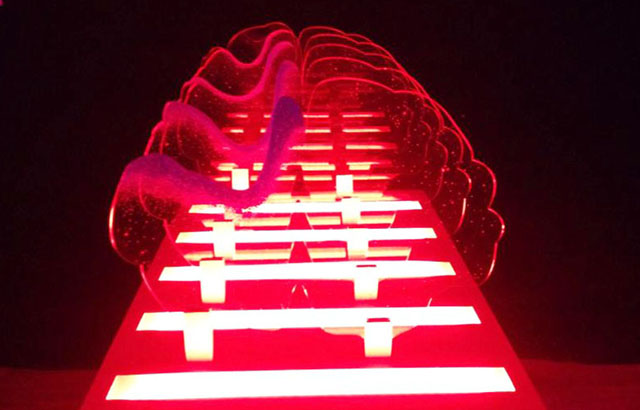Art Neuro: The art, and the science, behind collaborative public engagement

Written by Bryony Frost,
Public Engagement Officer at the Centre for Public Engagement
QMUL has a strong tradition of connecting those most unlikely of bedfellows – scientists and artists. From string theorists contributing to Turner Prize-winning walks through the park to engineers turning bridges into musical instruments, it is something we do, and do well. Nevertheless, I’ve never before seen such a broad range of collaborations as those on display at this weekend’s ArtNeuro exhibition.
Ranging from pottery to patchwork and Alzheimer’s to astroglia, this exhibition spanned disciplines – both in art and in neuroscience. But what really struck me was how this exhibition of 32 artists and scientists demonstrated the range of ways in which the two work together – and highlighted some of the challenges.
Take, for example, the brilliantly funny comic strip created by Freya Harrison inspired by David Baracchi’s work with bees. The piece tells the story of a laboratory bee yearning to be free, having fantasies of escape enhanced by the nicotine addiction the researchers are studying. The story is packed full of great science (did you know bees prefer blue flowers to pink ones?) but for me, felt sad, even ending with a note that the bees are destroyed at the end of research. It’s great that researchers open themselves up to scrutiny in this way - the researcher apparently thinks the piece is great. This kind of topic can be tricky to navigate in conversation and presentations – let alone in an art collaboration where the artist and scientists views, opinions and experiences combine.
Another interesting challenge is the way that science is presented. In one piece, created in collaboration with researchers who explore infant pain, the decision was taken to focus on the processes and data of the research, using visual metaphors for the different dyes and collection mechanisms. It reminds me that processes are as important as outcomes – to both artists and scientists.
So Art Neuro got my mind buzzing. I loved that it contained several examples of the different ways that artists and scientists can interact to create something new – the patchwork that attempted to demonstrate how autistic people feel and think was an eye opener. People with autism find it easier to focus on local details than global ones – so the patchwork encouraged you to focus on the local, switching perspectives. Another favourite was the artist who worked with an Alzheimer’s researcher. Copper can cause the brain to degrade – so the artist introduced copper wire into her pottery pieces, watching how they caused the pristine pottery to darken and distort, mirroring what happens to the brain during the illness.
I believe that art science collaborations do more than create beautiful things, but that they also enhance the way scientists see science and artists see art, as well as how they view each other’s disciplines. The whole breadth of possibilities was on show at Art Neuro.
For more information on the ArtNeuro exhibit and future projects visit their website.
By Bryony Frost
Public Engagement Officer
Queen Mary University of London